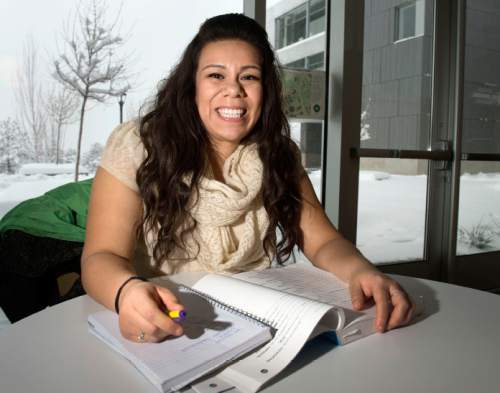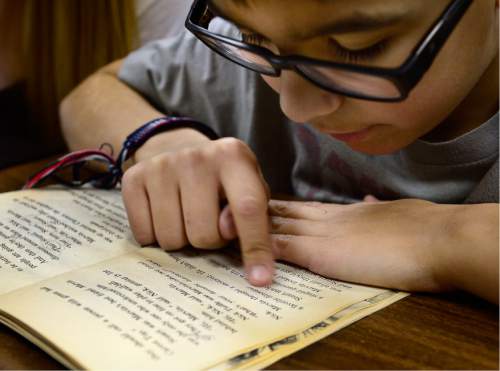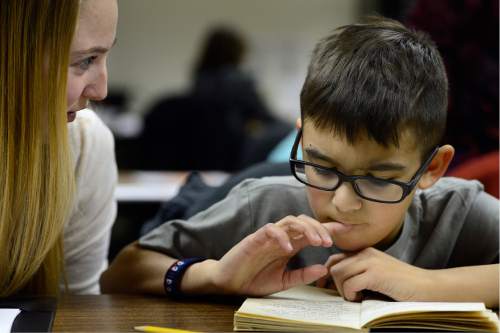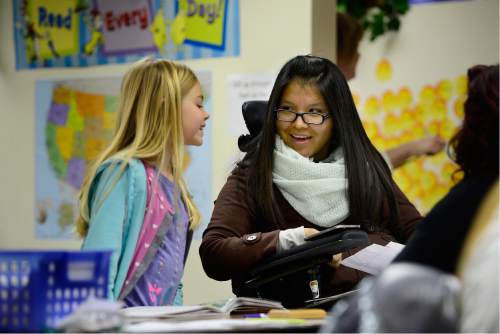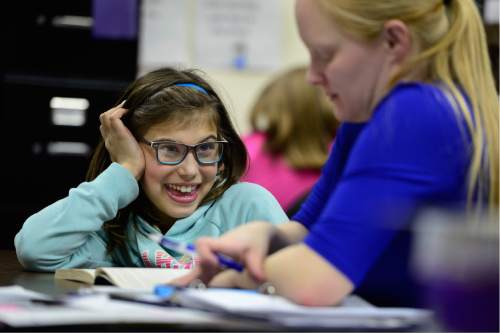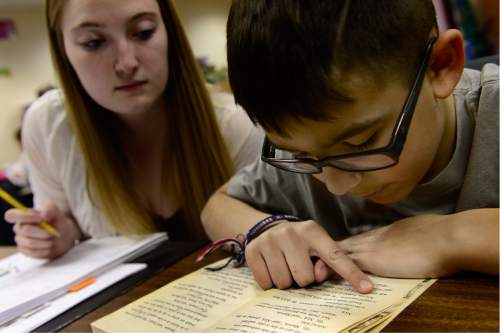This is an archived article that was published on sltrib.com in 2016, and information in the article may be outdated. It is provided only for personal research purposes and may not be reprinted.
Schools in the Beehive State are counting empty desks — at the head of the classroom.
"I can't produce enough teachers for the need," said Maria Franquiz, dean of the University of Utah's College of Education.
Around the state, education leaders are grappling with a lack of interest in their profession. Utah's K-12 schools are clamoring for teachers. But its colleges are struggling to churn them out.
Franquiz's department has 339 undergraduate students — about a third of the students it had in 2006, when the total was 914.
"We have a serious crisis on our hands," said Utah Education Association President Sharon Gallagher-Fishbaugh.
The boss over Utah's largest teachers union believes the shortfall is a symptom of issues facing education.
It's a national problem, with a 30 percent drop in teachers from 2008-2012, according to the U.S. Department of Education.
In schools, Utah's education graduates face the lowest per-student funding in the nation, prompting some to seek out higher-paying jobs in other states — or other industries that pay better and don't require hours grading papers after the workday is done.
Teachers also face an increasingly negative perception, Gallagher-Fishbaugh noted, exemplified at the Utah Capitol last yearwhen some legislators suggested teachers were lazy, and state School Superintendent Brad Smith likened teachers asking for more education funding to 3-year-old children crying for more presents on Christmas morning.
It was a gut punch to many Utah educators, who already feel vulnerable as student test scores become the measuring stick used to evaluate their progress.
"I have my friends saying, 'There's no way I would tell my child to go into education,' " Gallagher-Fishbaugh said.
Yet there's no lack of need. Some school districts are trying to lure Franquiz's already-dwindling students into classroom positions before graduation and license exams.
Utah's public school student population has ballooned by 23 percent in the past decade, according to state data.
A similar trend played out on college campuses. Undergraduate degrees grew 25 percent in that 10-year period, from 12,280 to the current 15,330. But the number of teaching diplomas lagged at a fifth of that rate. Last year, the Utah System of Higher Education graduated 1,350 teachers with bachelor's degrees — up a mere 5 percent from 10 years earlier.
At the U., Franquiz awarded about 10 percent fewer degrees last year than a decade earlier — 258, down from 282 in 2004-2005.
Ogden's Weber State University also has seen a dramatic drop.
Even as schoolwide enrollment swelled by 30 percent in the past decade, applications to its teaching program are down by 50 percent, from 286 in the 2004-2005 school year to 144 this fall.
"We're having a hard time enticing people into the profession," acknowledged Deputy State Superintendent Sydnee Dickson.
The negative effects were felt statewide this summer in Utah's elementary, middle and high schools, Dickson said. Vacant positions remained empty just weeks before the first day of school.
Granite School District edged out other schools in a statewide contest to fill teaching jobs by offering $500 bonuses to new hires. The cash prizes helped fill 14 percent of jobs — 500 out of a total 3,500. The perk offered by Utah's second-biggest district beefs up the profession's starting salary. The median yearly income for new teachers is $34,760, according to Department of Workforce Services data.
Granite anticipates the competition will be stiffer this year, with more school districts touting similar incentives.
Ben Horsley, Granite spokesman, does not expect the reward to solve the larger problem anytime soon. His co-workers in human resources have begun flying to Oregon and other states to persuade teachers to come to Utah. This year, more than 180 answered the call.
The need, he said, "peaked last year.
"It could get worse."
A 2007 state study showed the rate of college graduates seeking teaching careers was shrinking. It found new teachers often left the field within three years.
And, by 2017, the analysis forecast, half ofUtah's teachers will be eligible for retirement.
In the meantime, Dickson said, the Utah Office of Education is considering how to bolster preparation and mentoring to retain its current workers.
Franquiz and her colleagues are also trying to entice minority students and those who will be the first in their family to graduate from college.
Their most concentrated effort comes in a program that offers free tuition for teaching students who fulfill general requirements at Salt Lake Community College before shifting to the U.
But the mentoring and aid they offer are not enough to keep each scholar on the education path.
Several, such as 26-year-old Melissa Gutierrez, have switched to social work. Internships in both fields have helped Gutierrez realize she enjoys working one on one to help families through their struggles more than standing at the front of a classroom.
Other factors — including what she sees as a negative perception of Utah teachers — also weighed in her decision, Gutierrez said.
"It's hurtful to hear people say teachers don't work hard," she said, "because they have to put up with a lot."
aknox@sltrib.com Twitter: @anniebknox
Tribune reporter Benjamin Wood contributed to this story


